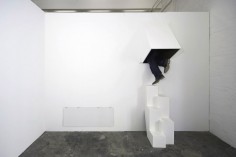The Chapuisat Brothers

source: socks-studio
The Chapuisat brothers are a Swiss duo of artists who produce constructions able to challenge the current habits in perceiving art installations. Their works are always revealed as visitable environments which the public is invited to explore.
Their series “Intra Muros” plays with the nature of art galleries, all become “white cubes”, and presents a clean wall, 50-60 cm thick, with the function of supporting other art pieces. At a closer look there’s much more: finding a small hatch on the side of the wall, a spectator can enter it and explore the inside like a speleologist. The wall is organized in a narrow interior pathway and divided in different sub-spaces which synthetize specific living areas like a kitchen, a closet, a restroom, minimal spaces for a paradoxical inhabitation. The pathway is not comfortable but requires the visitor to rely on his body strenght to be able to complete the exploration. Like for the iconic “Étant donnés” by M.Duchamp, the spectator is required to be curious, to explore and enjoy a hidden interior universe, opposed to the clean, predictable space of the art gallery.
A similar approach may be found in Chapuisat’s 2005 installation, “Hyperespace” in the Kunsthalle Sankt Gallen in Switzerland. Entering a hole in a wall the viewer will slide for several metres before being immersed in a labyrinthic space made of cardboard but perceived from the inside as a cave. Once inside, the only way for the visitors to get out is to crawl and wriggle through the complex pathway until he emerges on the other side.
.
.
.
.
.
.
.
source: ilikethisartnet
“We both received an artistic education abroad for a number of years before ending up in Geneva in 2001, where our contrasting experiences led us to develop an interest in spatial studies. Our constructions transform space, turning interior and exterior boundaries inside out and toying with the perception of a subjective reality. They demand visitors’ active participation, putting them into the position of being an explorer. These environments break down visual and intellectual habits, testing the explorers and obliging them to trust in their senses. Often compared to cocoons or burrows, these installations harbour striking powers. They provoke ambiguous emotional reactions in visitors, like dreams which mingle curiosity, surprise and discomfort.” – The Chapuisat Brothers

